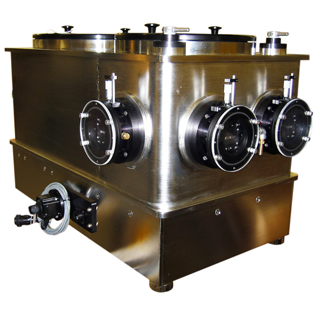
Vacuum Compatible Czerny-Turner Monochromator
The unique 670 mm focal length built clean and vacuum tight. Constructed of stainless steel this is a stable instrument suitable for any spectroscopy technique that requires vacuum or purge conditions. Use the large 120x140mm f/4.7 gratings to optimize for throughput. Opt for f/5.8 110*110mm gratings for the option to use a dual grating turret. High quality master optics provide excellent performance from about 105nm vacuum ultraviolet all the way to the Infrared. The optics are Aluminum and Magnesium Fluoride coated for best broadband performance. Coatings like Gold or Silver can also be provided.
Wavelengths from 105nm to 20-um can be covered within the scanning range and with appropriate gratings. The 207 optics provide best FWHM spectral resolution; aspheric optics are installed for imaging. The oversize output focusing mirror reduces intensity losses and delivers spectra to a large 50mm focal plane. Use it for Raman, Photoluminescence, Fluorescence, Emission, Reflection and Transmission.
| Optical Design | McPherson Model 207 0.67-meter focal length f/4.7 Monochromator |
| Focal Length | 0.67-meter, Czerny Turner design Spectrometer with Patented "Snap-In" gratings |
| f/no. | 4.7 (5.8 with smaller grating) |
| Wavelength Range | refer to grating of interest for range, in extended position increase top limit 20% |
| Wavelength Accuracy | +/-0.05 nm (with 1200 G/mm grating) |
| Wavelength Reproducibility | +/- 0.005 nm (with 1200 G/mm grating) |
| Grating Size | 120 x 140-mm (or 110 x 110-mm) - Echelle gratings up to 220-mm wide |
| Slit Locations | Axial and lateral with optional extra entrance and exit port selection mirrors |
| Focal Plane | 50-mm maximum width, multiply dispersion by the width of your detector for range |
| Grating (G/mm) (others available) | 3600 | 2400 | 1800 | 1200 | 600 | 300 | 150 | 75 | 20 |
| Wavelength Range from 185-nm to | 435nm | 650nm | 860nm | 1.3um | 2.6um | 5.2um | 10.4um | 20.8um | 78um |
| Resolution (nm)1 | 0.015 | 0.02 | 0.03 | 0.04 | 0.08 | 0.16 | 0.32 | 0.64 | 2.4 |
| Dispersion (nm/mm) | 0.42 | 0.62 | 0.83 | 1.24 | 2.48 | 4.96 | 9.92 | 19.84 | 74.4 |
| First Order Littrow Blaze (nm)2 | Holo | 240nm | Holo | 250nm | 300nm | 750nm | 1.25um | 2.0um | 45um |
| 300nm | 300nm | 500nm | 1.0um | 2.5um | 3.0um | ||||
| Holo | 500nm | 750nm | 3.0um | 4.0um | 8.0um | ||||
| 750nm | 1.0um | 4.0um | 6.0um | 10.0um | |||||
| 1.0um | 1.85um | 8.0um | 12.0um | ||||||
1. Tested in scanning mode at 312/313 nanometers with 10 micron wide slits and at slowest aperture ratio
2. Gratings work best from 2/3 blaze wavelength to 3/2 blaze wavelength